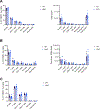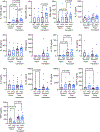Deficiency in the mitophagy mediator Parkin accelerates murine skin allograft rejection
- PMID: 39142471
- PMCID: PMC11588513
- DOI: 10.1016/j.ajt.2024.08.005
Deficiency in the mitophagy mediator Parkin accelerates murine skin allograft rejection
Abstract
Alterations in mitochondrial function and associated quality control programs, including mitochondrial-specific autophagy, termed mitophagy, are gaining increasing recognition in the context of disease. However, the role of mitophagy in organ transplant rejection remains poorly understood. Using mice deficient in Parkin, a ubiquitin ligase that tags damaged or dysfunctional mitochondria for autophagic clearance, we assessed the impact of Parkin-dependent mitophagy on skin-graft rejection. We observed accelerated graft loss in Parkin-deficient mice across multiple skin graft models. Immune cell distributions posttransplant were largely unperturbed compared to wild-type; however, the CD8+ T cells of Parkin-deficient mice expressed more T-bet, IFNγ, and Ki67, indicating greater priming toward effector function. This was accompanied by increased circulating levels of IL-12p70 in Parkin-deficient mice. Using a mixed leukocyte reaction, we demonstrated that naïve Parkin-deficient CD4+ and CD8+ T cells exhibit enhanced activation marker expression and proliferative responses to alloantigen, which were attenuated with administration of a pharmacological mitophagy inducer (p62-mediated mitophagy inducer), known to increase mitophagy in the absence of a functional PINK1-Parkin pathway. These findings indicate a role for Parkin-dependent mitophagy in curtailing skin-graft rejection.
Keywords: Parkin; T cells; mitochondria; mitophagy; transplant.
Copyright © 2024 The Authors. Published by Elsevier Inc. All rights reserved.
Conflict of interest statement
Declaration of competing interest The authors of this manuscript have no conflicts of interest to disclose as described by the American Journal of Transplantation.
Figures






Similar articles
-
CD8(+)IL-17(+) T Cells Mediate Neutrophilic Airway Obliteration in T-bet-Deficient Mouse Lung Allograft Recipients.Am J Respir Cell Mol Biol. 2015 May;52(5):622-33. doi: 10.1165/rcmb.2014-0059OC. Am J Respir Cell Mol Biol. 2015. PMID: 25286244 Free PMC article.
-
mTORC2 deficiency in cutaneous dendritic cells potentiates CD8+ effector T cell responses and accelerates skin graft rejection.Am J Transplant. 2019 Mar;19(3):646-661. doi: 10.1111/ajt.15083. Epub 2018 Sep 17. Am J Transplant. 2019. PMID: 30129283 Free PMC article.
-
Nitric oxide induction of Parkin translocation in PTEN-induced putative kinase 1 (PINK1) deficiency: functional role of neuronal nitric oxide synthase during mitophagy.J Biol Chem. 2015 Apr 17;290(16):10325-35. doi: 10.1074/jbc.M114.624767. Epub 2015 Feb 25. J Biol Chem. 2015. PMID: 25716315 Free PMC article.
-
The Role of PTEN-L in Modulating PINK1-Parkin-Mediated Mitophagy.Neurotox Res. 2022 Aug;40(4):1103-1114. doi: 10.1007/s12640-022-00475-w. Epub 2022 Jun 14. Neurotox Res. 2022. PMID: 35699891 Review.
-
Parkin and mitophagy in cancer.Oncogene. 2017 Mar;36(10):1315-1327. doi: 10.1038/onc.2016.302. Epub 2016 Sep 5. Oncogene. 2017. PMID: 27593930 Review.
References
-
- Hall BM, Gurley KE, Dorsch SE. The possible role of cytotoxic T cells in the mediation of first-set allograft rejection. Transplantation. Sep 1985;40(3):336–9. - PubMed
MeSH terms
Substances
Grants and funding
LinkOut - more resources
Full Text Sources
Molecular Biology Databases
Research Materials

